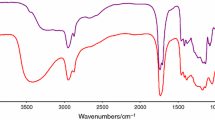Abstract
Hyperbranched poly(ester)s offer attractive features for applications in a number of areas, particularly as platforms for the support of controlled release actives in the agricultural and biomedical fields. Such materials have been generated from trimethylolpropane and adipic acid, and fully characterized using chromatographic, spectroscopic, and thermal methods. The thermal stability of these polymers has been assessed using thermogravimetry and infrared spectroscopy. The degradation characteristics of these materials have been compared to those of two linear adipic acid polymers. The prominent feature of the thermal degradation of the hyperbranched poly(ester)s is ether formation while that for the comparable linear poly(ester)s is ester pyrolysis resulting in chain scission.




























Similar content being viewed by others
References
Yan D, Geo G, Frey H, editors. Hyperbranched polymers: synthesis, properties and applications. Hoboken: Wiley; 2011.
Li H, Cooper-White JJ, Kim I. Facile and controllable incorporation of gold nanoparticles within one-dimensional self-assemblies of hyperbranched polymers. Soft Matter. 2013 9:5270–6.
Kricheldorf HR, Zolotukin MG, Cardenas J. Non-stoichiometric polycondensations and the synthesis of high molar mass polycondensates. Macromol Rapid Commun. 2012;33:1814–32.
Zhang T, Howell BA, Dumitrascu A, Smith PB Dvornic P. Thermal properties of hyperbranched poly(ester)s, Proceedings, 40th Annual Technical Meeting of the North American Thermal Analysis Society, 2012.
Zhou Z, Jia Z, Yan D. Theoretical investigation on the polyaddition of A2 and CB2 monomers with non-equal reactivity. Polymer. 2009;50:5608–12.
Shenoi RA, Lai BFL, Kizhakkedathu JN. Synthesis, characterization, biocompatibility of biodegradable hyperbranched polyglycerols from acid-cleavable ketal group functionalized initiators. Biomacromolecules. 2012;10:3018–30.
Zhang H, Patel A, Gaharwar AK, Mihaila SM, Iviglia G, Mukundan S, Bae H, Yang H, Khademhosseini A. Hyperbranched polyester hydrogels with controlled drug release and cell adhesion properties. Biomacromolecules. 2013;14:1299–310.
Min K, Gao H. New method to access hyperbranched polymers with uniform structure via one-pot polymerization of inimers in microemulsion. J Am Chem Soc. 2012;134:15680–3.
Jikei M, Suzuki M, Itoh K, Matsumoto K, Saito Y, Kawaguchi S. Synthesis of hyperbranched poly(l-lactide)s by self-polycondensation of AB2 macromonomers and their structural characterization by light scattering measurements. Macromolecules. 2012;45:8237–44.
Bao Y, He J, Li Y. Facile and efficient synthesis of hyperbranched polyesters based on renewable caster oil. Polym Int. 2012;62:1457–64.
Li Y, Cook WD, Moorhoff C, Huong W-C, Chen Q-Z. Synthesis, characterization and properties of biocompatible poly(glycerol sebacate) pre-polymer and gel. Polym Int. 2013;62:534–47.
Goodwin A, Baskaran D. Inimer mediated synthesis of hyperbranched polyglycerol via self-condensing ring-opening polymerizaiton. Macromolecules. 2012;45:9657–65.
Ul-haq MI, Shenoi RA, Brooks DE, Kizhakkedathu JN. Solvent-assisted anionic ring opening polymerization of glycidol: toward medium and high molecular weight hyperbranched polyglycerols. J Polym Sci Polym Chem. 2013;51:2614–21.
Macosko CW, Miller DR. A new derivation of average molecular weights of nonlinear polymers. Macromolecules. 1976;9(2):199–206.
Zhang T, Howell BA, Martin PK, Martin SJ, Smith PB. Synthesis and NMR characterization of HBPEs from TMP and AA. In: Cheng HN, Gross RA, Smith PB, editors. Biocatalysis and biobased materials (ACS symposium series). Washington, DC: American Chemical Society; 2013.
Dvornic PR, Hu J, Meier DJ, Nowak RM, Parha PL. Hyperbranched polymers by multimonomer polymerization. US patent 6,812,298; 2004.
Smith PB, Zhang T, Dvornic PR, Martin PK, Martin SJ, Howell BA. Characterization of biobased hyperbranched poly(ester)s using NMR spectroscopy. Polym Prepr. 2012;53(1):55–6.
Persenaire O, Alexandre M, Degée P, Dubois P. Mechanisms and kinetics of thermal degradation of poly(ε-caprolactone). Biomacromolecules. 2001;2:288–94.
Goldfarb IJ, McGuchan R. Thermal degradation of poly(ester)s I. aliphatic polymers. Technical Report AFML-TR-68-182, Part I, Air Force Materials Laboratory, Wright-Patterson Air Force Base, OH; 1968.
Grassie N. Recent work on the thermal degradation of acrylate and methacrylate homopolymers and copolymers. Pure Appl Chem. 1972;30:119–34.
Holland BJ, Hay JN. The thermal degradation of PET and analogous polyesters measured by thermal analysis-Fourier transform infrared spectroscopy. Polymer. 2002;43:1835–47.
Hujuri U, Ghoshal AK, Gumma S. Temperature-dependent pyrolytic product evolution profile for polyethylene terephthalate. J Appl Polm Sci. 2013;130:3993–4000.
Atkinson JL, Vyazovkin S. Thermal properties and degradation behavior of linear and branched poly(l-lactide)s and poly(l-lactide-co-glycolide)s. Macromol Chem Phys. 2012;213:924–36.
Author information
Authors and Affiliations
Corresponding author
Rights and permissions
About this article
Cite this article
Zhang, T., Howell, B.A. & Smith, P.B. Thermal degradation of trimethylolpropane/adipic acid hyperbranched poly(ester)s. J Therm Anal Calorim 116, 1369–1378 (2014). https://doi.org/10.1007/s10973-014-3656-z
Received:
Accepted:
Published:
Issue Date:
DOI: https://doi.org/10.1007/s10973-014-3656-z




